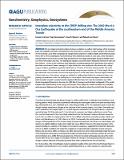Por favor, use este identificador para citar o enlazar a este item:
http://hdl.handle.net/10261/103304COMPARTIR / EXPORTAR:
 SHARE SHARE
 CORE
BASE CORE
BASE
|
|
| Visualizar otros formatos: MARC | Dublin Core | RDF | ORE | MODS | METS | DIDL | DATACITE | |

| Título: | Interplate seismicity at the CRISP drilling site: The 2002 Mw 6.4 Osa Earthquake at the southeastern end of the Middle America Trench |
Autor: | Arroyo, Ivonne G.; Grevemeyer, Ingo; Ranero, César R. CSIC ORCID; Von Huene, Roland | Fecha de publicación: | 31-jul-2014 | Editor: | American Geophysical Union | Citación: | Geochemistry, Geophysics, Geosystems 15(7): 3035-3050 (2014) | Resumen: | We investigate potential relations between variations in seafloor relief and age of the incoming plate and interplate seismicity. Westward from Osa Peninsula in Costa Rica, a major change in the character of the incoming Cocos Plate is displayed by abrupt lateral variations in seafloor depth and thermal structure. Here a Mw 6.4 thrust earthquake was followed by three aftershock clusters in June 2002. Initial relocations indicate that the main shock occurred fairly trenchward of most large earthquakes along the Middle America Trench off central Costa Rica. The earthquake sequence occurred while a temporary network of OBH and land stations ∼80 km to the northwest were deployed. By adding readings from permanent local stations, we obtain uncommon P wave coverage of a large subduction zone earthquake. We relocate this catalog using a nonlinear probabilistic approach within both, a 1-D and a 3-D P wave velocity models. The main shock occurred ∼25 km from the trench and probably along the plate interface at 5-10 km depth. We analyze teleseismic data to further constrain the rupture process of the main shock. The best depth estimates indicate that most of the seismic energy was radiated at shallow depth below the continental slope, supporting the nucleation of the Osa earthquake at ∼6 km depth. The location and depth coincide with the plate boundary imaged in prestack depth-migrated reflection lines shot near the nucleation area. Aftershocks propagated downdip to the area of a 1999 Mw 6.9 sequence and partially overlapped it. The results indicate that underthrusting of the young and buoyant Cocos Ridge has created conditions for interplate seismogenesis shallower and closer to the trench axis than elsewhere along the central Costa Rica margin. © 2014. American Geophysical Union. All Rights Reserved | Descripción: | 16 pages, 9 figures | Versión del editor: | https://doi.org/10.1002/2014GC005359 | URI: | http://hdl.handle.net/10261/103304 | DOI: | 10.1002/2014GC005359 | Identificadores: | doi: 10.1002/2014GC005359 e-issn: 1525-2027 |
| Aparece en las colecciones: | (ICM) Artículos |
Ficheros en este ítem:
| Fichero | Descripción | Tamaño | Formato | |
|---|---|---|---|---|
| Arroyo_et_al_2014.pdf | 1,7 MB | Adobe PDF |  Visualizar/Abrir |
CORE Recommender
SCOPUSTM
Citations
23
checked on 12-abr-2024
WEB OF SCIENCETM
Citations
22
checked on 23-feb-2024
Page view(s)
319
checked on 19-abr-2024
Download(s)
338
checked on 19-abr-2024
Google ScholarTM
Check
Altmetric
Altmetric
NOTA: Los ítems de Digital.CSIC están protegidos por copyright, con todos los derechos reservados, a menos que se indique lo contrario.
